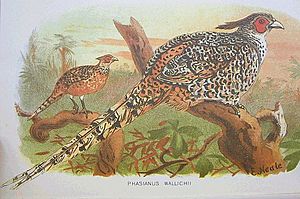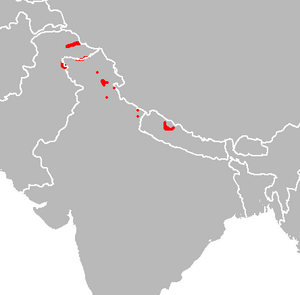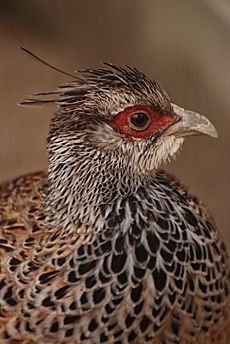Cheer pheasant facts for kids
Quick facts for kids Cheer Pheasant |
|
|---|---|
 |
|
| Conservation status | |
| Scientific classification | |
| Kingdom: | |
| Phylum: | |
| Class: | |
| Order: | |
| Family: | |
| Subfamily: |
Phasianinae
|
| Genus: |
Catreus
Cabanis, 1851
|
| Species: |
C. wallichii
|
| Binomial name | |
| Catreus wallichii (Hardwicke, 1827)
|
|
 |
|
| Range of Catreus wallichii | |
| Synonyms | |
The Cheer Pheasant (Catreus wallichii) is also known as Wallich's Pheasant. In Nepal, people call it "Kahir" or "Chihir". This bird is a vulnerable species, which means it is at risk of disappearing. It belongs to the pheasant family, called Phasianidae. The Cheer Pheasant is the only type of bird in its group, known as the genus Catreus.
An English zoologist named Thomas Hardwicke first described this bird in 1827. He named it Phasianus wallichi after a Danish botanist, Nathaniel Wallich. Later, another English bird expert, John Gould, changed its name to the one we use today.
Contents
What Does the Cheer Pheasant Look Like?
The Cheer Pheasant is not as brightly colored as many other pheasants. The male bird has feathers that are yellowish-brown. It also has black marks and a long, gray crest on its head. The skin around its face is red.

Its long tail is mostly gray and brown. This tail has 18 feathers, which is a special feature that helps tell it apart from similar birds.
The female Cheer Pheasant is smaller than the male. Her feathers are a bit duller and have more markings. She has less red skin on her face and a shorter crest.
Where Do Cheer Pheasants Live?
Cheer Pheasants live only in the western Himalayas. This means they are endemic to that area. You can find them in the high lands and scrublands. Scrublands are places with many small shrubs and plants, but no trees.
These birds usually live at heights from 1,455 to 3,050 meters (about 4,774 to 10,000 feet). Their home range stretches from northern Pakistan, through Kashmir, Himachal Pradesh, and Uttarakhand in India, all the way to central Nepal.
Scientists have done surveys to count these birds. In 1981 and 2003, surveys in Nepal found many places where Cheer Pheasants were heard. This suggested there were about 200 birds in that area. Another survey in 2010 found Cheer Pheasants in 21 different spots in Himachal Pradesh, India.
How Do Cheer Pheasants Live?
Cheer Pheasants often travel in groups for most of the year. These groups usually have five to fifteen birds. However, during the breeding season, from late April to June, they form pairs. They are monogamous, meaning they stay with one partner.
They build their nests on steep cliffs during the summer. They lay many eggs; usually ten to eleven eggs are in each nest. Sometimes, there can be as many as 14 eggs.
Cheer Pheasants find most of their food on the ground. They use their strong beaks to dig for roots, tubers, bulbs, and seeds. They also eat insects and other small animals. They look for food mainly in the morning and evening. They usually walk around in pairs or sometimes in family groups.
Studies have shown that Cheer Pheasants are sensitive to humans being around them.
Protecting the Cheer Pheasant
The Cheer Pheasant is a Vulnerable bird. This means it is at risk because its home is shrinking. Also, there are not many of these birds left, and they are sometimes hunted. The IUCN Red List of Threatened Species lists them as vulnerable.
They are also listed on Appendix I of CITES. This is an international agreement that helps protect endangered animals and plants. Cheer Pheasants are legally protected in Nepal and India. They live in at least 12 protected areas in Himachal Pradesh, three in Uttar Pradesh, and three in Nepal.
Sadly, attempts to release Cheer Pheasants raised in zoos back into the wild in Pakistan have not worked out.
Images for kids
See also
 In Spanish: Faisán chir para niños
In Spanish: Faisán chir para niños






